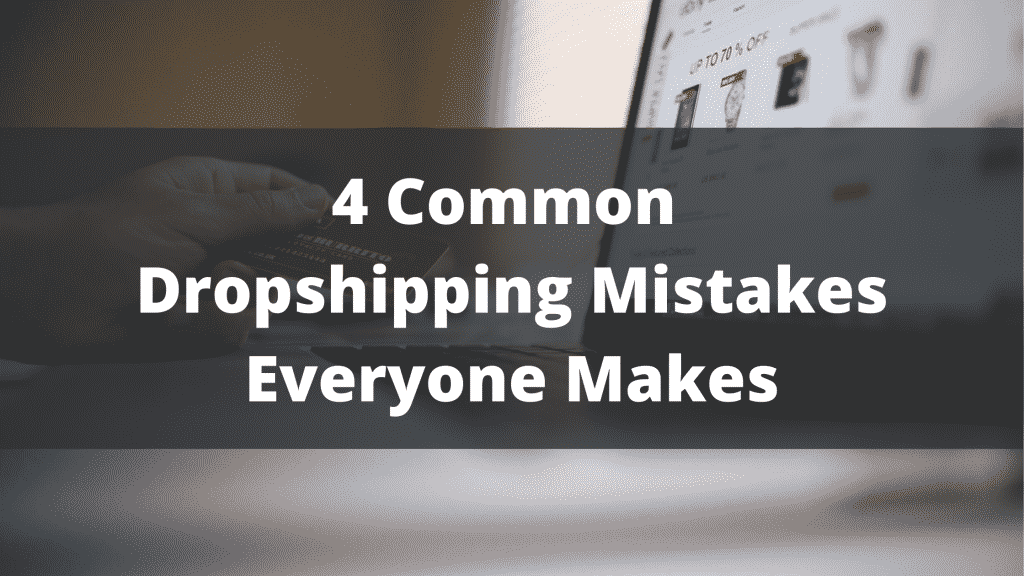Dropshipping — a business model based on selling products that are actually stocked and dispatched on your behalf directly from a supplier — can seem like a quick and easy route to launching an ecommerce business.
It’s fairly simple to set up with a lot of potential, but are there any dropshipping mistakes you can make? You don’t need loads of retail experience to get started, you don’t need to invest large sums of money upfront, and you can run a dropshipping business from anywhere in the world without worrying about storing stock.
Sounds too good to be true, right? One of the main problems with starting a dropshipping business is the fact that there are so many others doing the exact same thing. And with stiff competition, it’s important to avoid making these common pitfalls:

Contents
Choosing the wrong niche
When you start a dropshipping business you aren’t just competing with thousands of other dropshippers, but you’ll be up against large retailers like Amazon, as well as every other ecommerce company out there.
One of the most basic mistakes to make with dropshipping is to start selling in the wrong niche, especially if you choose a really broad market without targeting any specific section.
It can take some time and research to find a specific niche, but it’s much better than investing effort into trying to join an already crowded market.
The more specific you can get with your products the better chance you have of standing out from other retailers. Look at current trends and trends that are up and coming, find some area of those markets that you can corner for your business.
Selling products with low profit margins
Deciding which products to sell isn’t easy. It needs to be something that people want to buy, but it also needs to provide a good enough profit margin to make it worthwhile.
The profit in dropshipping only comes from the difference between what the supplier charges and what the business charges customers. The markups that make dropshipping worthwhile are hard to justify for a lot of products.
It can be tempting to choose expensive items to sell such as laptops or mobile phones. But these products are highly competitive, with lots of other retailers selling them at a recommended retail price.
It would be hard to add on your own mark-up — even an extra 2% ends up being a noticeable amount because the product already costs a lot. And, you’re unlikely to be getting wholesale discounts on your products because the supplier is sending each order out individually.
Smaller items like phone cases, stands or other accessories are usually offered at a huge range in price. It’s possible to take something quite basic, arrange for branded packaging, and mark up the price considerably – it just needs to stand out as a unique or good value product.
Poor marketing
Dropshippers often forget the importance of marketing for their business. It’s easy to set up your website, find a supplier, and start trying to sell products – but how will anyone ever find your products? And what makes them choose to buy from you over the thousands of other retailers?
Without unique products made exclusively for your business, you’re essentially selling the same generic items as everyone else. And, you can’t afford to slash your prices to beat the competition.
You need to invest time and money in marketing your store and your products. This starts with a great website that looks good and is full of well-written, SEO optimized copy and product descriptions.
Product photography is also important — it’s tempting to use the standard images from the supplier, but you can make the product look completely different with your own images.
Only once the website is up to scratch, should you start using paid advertising. Splashing a load of money on pay-per-click advertising (PPC) straight away is another common mistake.
As entrepreneur and dropshipping expert, Tim Kock, explains “instead of just paying for ads, you have to provide real value”. There’s no point paying to get customers to your site if it doesn’t convince them to buy when they get there.
Relying on a single supplier
Dropshipping successfully is completely dependent on how reliable the suppliers are. You can have the best products and excellent marketing, but the whole process of picking, packing and shipping products is out of your hands.
And if anything goes wrong with the order, the customer doesn’t care that it’s the supplier’s issue – they just want it resolved.
One of the most common mistakes in dropshipping, is placing all your eggs in one basket and using just one supplier. It’s easy to start off with one good supplier, but any problems with stock levels or fulfillment can quickly escalate into a bigger issue if there’s no backup.
Try using two or three different suppliers so that when they run out of certain items customers can still get their orders, and you don’t have to update your site to say they’re out of stock and miss out on sales.
It’s also important to ask each supplier for daily inventory reports or the ability to track their inventory in real time so you can keep stock levels accurate as much as possible.
Conclusion: 4 Common Dropshipping Mistakes Everyone Makes
Dropshipping can be a great business opportunity with minimal investment and high returns, but there are still some big challenges to navigate. Learn from these common dropshipping mistakes and you’ll be able to set yourself apart from the competition and grow a successful business.


Pingback: How Dropshipping Works -